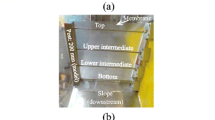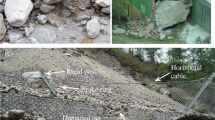Abstract
Debris flow normally occurs after heavy rains in mountainous regions with multiple surges. Flexible barriers are installed in torrents to intercept debris flows in an early stage. For the safer design of a flexible barrier installed in the upstream, the forces on the barrier invaded by debris flows should be taken into consideration. An outdoor physical modelling facility was utilized to study the interaction between debris flows and a flexible barrier. Three continuous debris flow impact tests were conducted to investigate the performance of a flexible barrier affected and overflowed by multiple surges of debris flow. A parameter named Initial Block Ratio (IBR) is introduced in this study to describe the initial condition of a flexible barrier filled by the earlier debris flow surges. By analysing the results of these tests, the dynamic response of a flexible barrier under the impact of multiple surges of debris flow is studied, and the influence of IBR on the interaction of debris flow with the flexible barrier is investigated. Based on the findings of the experimental study, a new simple method is proposed to calculate the loads on a filled flexible barrier overflowed by debris flow. By comparing with the measured impact force in the overflow test, this method has a good performance and can be utilized in design analysis with further calibration.










Similar content being viewed by others
References
Armanini A (1997) On the dynamic impact of debris flows. In: Recent developments on debris flows. Springer, Berlin, pp 208–226
Ashwood W, Hungr O (2016) Estimating total resisting force in flexible barrier impacted by a granular avalanche using physical and numerical modeling. Can Geotech J 53(10):1700–1717
Ayotte D, Evans N, Hungr O (1999) Runout analysis of debris flows and avalanches in Hong Kong. In Proceedings, Slope Stability and Landslides, Vancouver Geotechnical Society Symposium, 39–46
Bertolo P, Wieczorek GF (2005) Calibration of numerical models for small debris flows in Yosemite Valley, California, USA. Nat Hazards Earth Syst Sci 5(6):993–1001
Bowman ET, Laue J, Imre B, Springman SM (2010) Experimental modelling of debris flow behaviour using a geotechnical centrifuge. Can Geotech J 47(7):742–762
Chen HX, Zhang LM, Gao L, Yuan Q, Lu T, **ang B, Zhuang WL (2017) Simulation of interactions among multiple debris flows. Landslides 14(2):595–615
Choi CE, Ng CWW, Song D, Kwan JHS, Shiu HYK, Ho KKS, Koo RCH (2014) Flume investigation of landslide debris–resisting baffles. Can Geotech J 51(5):540–553
Choi CE, Ng CWW, Liu H, Wang Y (2019) Interaction between dry granular flow and rigid barrier with basal clearance: analytical and physical modelling. Canadian Geotechnical Journal, (ja)
Costa JE (1984) Physical geomorphology of debris flows. In: Developments and applications of geomorphology. Springer, Berlin, pp 268–317
Cui YF, Zhou XJ, Guo CX (2017) Experimental study on the moving characteristics of fine grains in wide grading unconsolidated soil under heavy rainfall. J Mt Sci 14(3):417–431
Cui YF, Choi CE, Liu LH, Ng CW (2018) Effects of particle size of mono-disperse granular flows impacting a rigid barrier. Nat Hazards 91(3):1179–1201
Glassey T (2013) Hydrology and check dams analysis in the debris flow context of Illgraben torrent. MAS practical research project, Swiss Federal Institute of Technology Zurich, Zurich
Hungr O (1998) Mobility of landslide debris in Hong Kong: pilot back analyses using a numerical model. Report prepared for the Geotechnical Engineering Office, Hong Kong, p 50
Hungr O, Morgan GC, Kellerhals R (1984) Quantitative analysis of debris torrent hazard for design of remedial measures. Can Geotech J 21:663–667
Hussin HY, Quan LB, Van Westen CJ, Christen M, Malet JP, van Asch TW (2012) Parameterization of a numerical 2-D debris flow model with entrainment: a case study of the Faucon catchment, Southern French Alps. Nat Hazards Earth Syst Sci 12:3075–3090. https://doi.org/10.5194/nhess-12-3075-2012
Iverson RM (2015) Scaling and design of landslide and debris-flow experiments. Geomorphology 244:9–20
Iverson RM, Costa JE, LaHusen RG (1992) Debris-flow flume at HJ Andrews experimental forest, Oregon. US Geological Survey, Dept. of the Interior
Iverson RM, Logan M, LaHusen RG, Berti M (2010) The perfect debris flow? Aggregated results from 28 large-scale experiments. J Geophys Res 115:F03005 (Art. No.)
Kailey P, Bowman ET, Laue J, Springman SM (2011) Modelling debris flow processes with a geotechnical centrifuge. Italian Journal of Engineering Geology and Environment 3:339–349
Kean JW, McCoy SW, Tucker GE, Staley DM, Coe JA (2013) Runoff-generated debris flows: observations and modeling of surge initiation, magnitude, and frequency. J Geophys Res Earth Surf 118(4):2190–2207
King JP (2013) Tsing Shan debris flow and debris flood (GEO Report 281). Geotechnical Engineering Office, HKSAR, 268
Kwan JSH, Cheung RWM (2012) Suggestion on design approaches for flexible debris-resisting barriers. Discussion Note DN1/2012. The Government of Hong Kong Standards and Testing Division, Hong Kong
Kwan JS, Chan SL, Cheuk JC, Koo RCH (2014) A case study on an open hillside landslide impacting on a flexible rockfall barrier at Jordan Valley, Hong Kong. Landslides 11(6):1037–1050
Lichtenan C (1973) Die Berechnung von Sperren in Beton und Eisenbeton, Kolloquium on Torrent Dams ODC 384.3. Mitteilungen der Forstlichen Bundes-Versuchsanstalt, Wien, pp 91–127 (in German)
McCoy SW, Kean JW, Coe JA, Staley DM, Wasklewicz TA, Tucker GE (2010) Evolution of a natural debris flow: in situ measurements of flow dynamics, video imagery, and terrestrial laser scanning. Geology 38(8):735–738
Naef D, Rickenmann D, Rutschmann P, McArdell BW (2006) Comparison of flow resistance relations for debris flows using a one-dimensional finite element simulation model. Nat Hazards Earth Syst Sci 6(1):155–165
Ng AKL, Williamson SJ, Chong AKT (2012) Developments in design considerations and use of flexible barriers as mitigation measures for channelised debris flow and open hillslope failures - a case study. In Proceedings of the One Day Seminar on Natural Terrain Hazard Mitigation Measures. At Kowloon, Hong Kong
Ng CWW, Choi CE, Koo RCH, Goodwin GR, Song D, Kwan JSH (2017) Dry granular flow interaction with dual-barrier systems. Géotechnique 68(5):386–399
Paik J, Son S, Kim T, Kim S (2012) A real-scale field experiment of debris flow for investigating its deposition and entrainment. In AGU Fall Meeting Abstracts
Rickenmann D, Laigle DMBW, McArdell BW, Hübl J (2006) Comparison of 2D debris-flow simulation models with field events. Comput Geosci 10(2):241–264
Scotton P, Deganutti AM (1997) Phreatic line and dynamic impact in laboratory debris flow experiments. In Debris-flow hazards mitigation: mechanics, prediction, and assessment, 777–786
Shum LKW, Lam AYT (2011) Review of natural terrain landslide risk management practice and mitigation measures, Technical Note TN 3/2011. Geotechnical Engineering Office, Civil Engineering and Development Department, The HKSAR Government, Hong Kong
Song D, Choi CE, Ng CWW, Zhou GGD (2018) Geophysical flows impacting a flexible barrier: effects of solid-fluid interaction. Landslides 15(1):99–110
Song D, Zhou GG, Xu M, Choi CE, Li S, Zheng Y (2019) Quantitative analysis of debris-flow flexible barrier capacity from momentum and energy perspectives. Eng Geol 251:81–92
Su LJ, Xu XQ, Genge XY, Liang SQ (2017) An integrated geophysical approach for investigating hydro-geological characteristics of a debris landslide in the Wenchuan Earthquake Area. Eng Geol 219:52–63. https://doi.org/10.1016/j.enggeo.2016.11.020
Tan DY, Yin JH, Feng WQ, Qin JQ, Zhu ZH (2018a) Large-scale physical modelling study of a flexible barrier under the impact of granular flows. Nat Hazards Earth Syst Sci 18:2625–2640. https://doi.org/10.5194/nhess-18-2625-2018
Tan DY, Yin JH, Qin JQ, Zhu ZH, Feng WQ (2018b) Large-scale physical modeling study on the interaction between rockfall and flexible barrier. Landslides 15(12):2487–2497
Turnbull B, Bowman ET, McElwaine JN (2015) Debris flows: experiments and modelling. C R Phys 16(1):86–96
Voellmy A (1955) Uber die Zerstorungskraft von Lawinen. Schweizerische Bauzeitung, Jahrg 73:159–162
Volkwein A (2014) Flexible debris flow barriers. Design and application. WSL Berichte. Issue 18, 29
Volkwein A, Wendeler C, Guasti G (2011) Design of flexible debris flow barriers. In: 5th International Conference debris-flow hazard mitigation. Mechanics, prediction and assessment, Padua, pp 1093–1100
Wendeler C (2008) Murgangrückhalt in Wildbächen: Grundlagen zu Planung und Berechnung von flexiblen Barrieren (Doctoral dissertation), ETH, Zurich
Wendeler C (2016) Debris-flow protection systems for mountain torrents: basics principles for planning and calculation of flexible barriers. WSL Berichte 44:281
Wendeler C, Volkwein A (2015) Laboratory tests for the optimization of mesh size for flexible debris-flow barriers. Nat Hazards Earth Syst Sci 3(3) Discussions
Wendeler C, McArdell B, Volkwein A, Denk M, Gröner E (2008) Debris flow mitigation with flexible ring net barriers—field tests and case studies. WIT Trans Eng Sci 60:23–31
Wendeler C, Volkwein A, McArdell BW, Bartelt P (2018) Load model for designing flexible steel barriers for debris flow mitigation. Can Geotech J 99:1–39
WSL (Swiss Federal Institute for Snow and Avalanche Research) (2008) Integral risk management of extremely rapid mass movements. WSL, Birmensdorf
Xu Q, Zhang S, Li WL, Van Asch TW (2012) The 13 August 2010 catastrophic debris flows after the 2008 Wenchuan earthquake, China. Nat Hazards Earth Syst Sci 12:201–216
Yagi H, Sato G, Higaki D, Yamamoto M, Yamasaki T (2009) Distribution and characteristics of landslides induced by the Iwate–Miyagi Nairiku Earthquake in 2008 in Tohoku District, Northeast Japan. Landslides 6(4):335
Yifru AL (2014) Assessment of rheological models for run-out distance modeling of sensitive clay slides, focusing on Voellmy rheology (master’s thesis). Norwegian University of Science and Technology, Trondheim, Norway
Zanuttigh B, Lamberti A (2007) Instability and surge development in debris flows. Rev Geophys 45(3)
Shi XS, Nie JY, Zhao JD, Gao YF, (2020) A homogenization equation for the small strain stiffness of gap-graded granular materials. Comput Geotech 121:103440
Funding
The work in this paper is supported by grants (1-BBAG, 1-ZVEH, 3-RBCE, 4-BCAW, 5-ZDAF, G-YN97, B-Q43L, B-Q55N) from The Hong Kong Polytechnic University, China. The work also received supports by a CRF project (Grant No. PolyU12/CRF/13E) from Research Grants Council (RGC) of Hong Kong Special Administrative Region Government of China, and Research Institute for Sustainable Urban Development of The Hong Kong Polytechnic University (PolyU), Center for Urban Geohazard and Mitigation of Faculty of Construction and Environment of PolyU, and Geotechnical Engineering Office of the Civil Engineering and Development Department of the Government of the Hong Kong Special Administrative Region.
Author information
Authors and Affiliations
Corresponding author
Rights and permissions
About this article
Cite this article
Tan, DY., Yin, JH., Qin, JQ. et al. Experimental study on impact and deposition behaviours of multiple surges of channelized debris flow on a flexible barrier. Landslides 17, 1577–1589 (2020). https://doi.org/10.1007/s10346-020-01378-7
Received:
Accepted:
Published:
Issue Date:
DOI: https://doi.org/10.1007/s10346-020-01378-7




